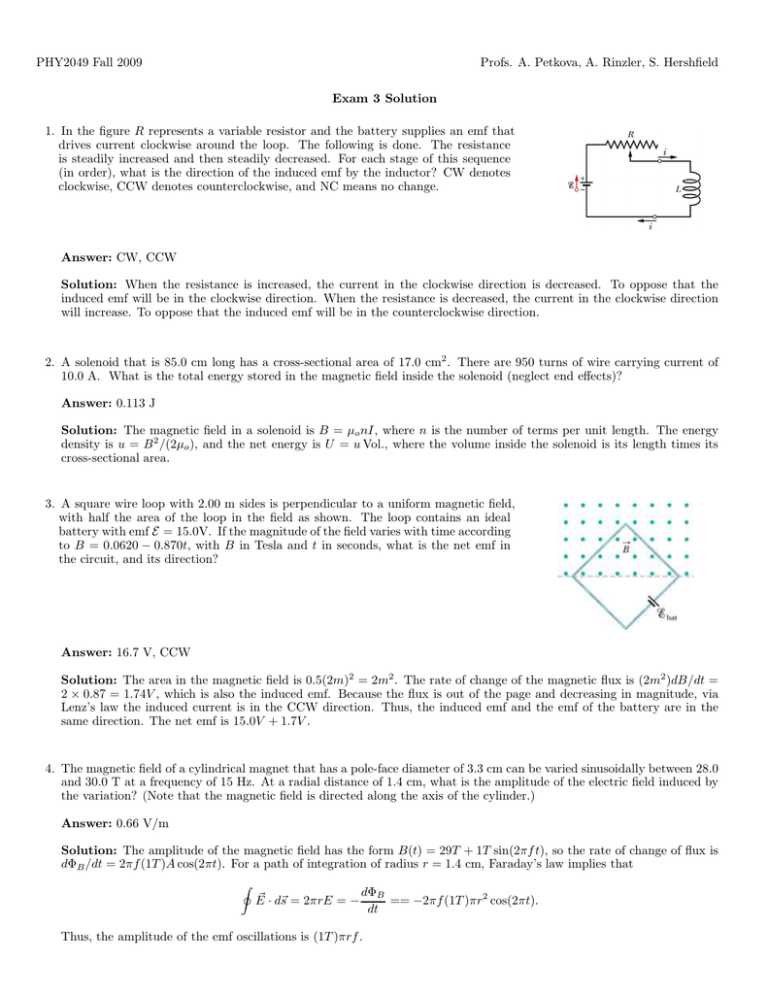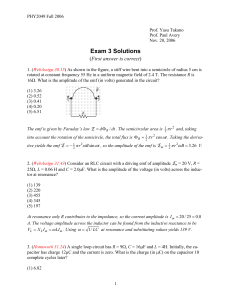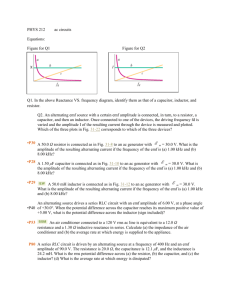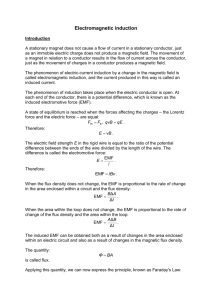PHY2049 Fall 2009 Profs. A. Petkova, A. Rinzler, S. Hershfield
advertisement

PHY2049 Fall 2009 Profs. A. Petkova, A. Rinzler, S. Hershfield Exam 3 Solution 1. In the figure R represents a variable resistor and the battery supplies an emf that drives current clockwise around the loop. The following is done. The resistance is steadily increased and then steadily decreased. For each stage of this sequence (in order), what is the direction of the induced emf by the inductor? CW denotes clockwise, CCW denotes counterclockwise, and NC means no change. Answer: CW, CCW Solution: When the resistance is increased, the current in the clockwise direction is decreased. To oppose that the induced emf will be in the clockwise direction. When the resistance is decreased, the current in the clockwise direction will increase. To oppose that the induced emf will be in the counterclockwise direction. 2. A solenoid that is 85.0 cm long has a cross-sectional area of 17.0 cm2 . There are 950 turns of wire carrying current of 10.0 A. What is the total energy stored in the magnetic field inside the solenoid (neglect end effects)? Answer: 0.113 J Solution: The magnetic field in a solenoid is B = µo nI, where n is the number of terms per unit length. The energy density is u = B 2 /(2µo ), and the net energy is U = u Vol., where the volume inside the solenoid is its length times its cross-sectional area. 3. A square wire loop with 2.00 m sides is perpendicular to a uniform magnetic field, with half the area of the loop in the field as shown. The loop contains an ideal battery with emf E = 15.0V. If the magnitude of the field varies with time according to B = 0.0620 − 0.870t, with B in Tesla and t in seconds, what is the net emf in the circuit, and its direction? Answer: 16.7 V, CCW Solution: The area in the magnetic field is 0.5(2m)2 = 2m2 . The rate of change of the magnetic flux is (2m2 )dB/dt = 2 × 0.87 = 1.74V , which is also the induced emf. Because the flux is out of the page and decreasing in magnitude, via Lenz’s law the induced current is in the CCW direction. Thus, the induced emf and the emf of the battery are in the same direction. The net emf is 15.0V + 1.7V . 4. The magnetic field of a cylindrical magnet that has a pole-face diameter of 3.3 cm can be varied sinusoidally between 28.0 and 30.0 T at a frequency of 15 Hz. At a radial distance of 1.4 cm, what is the amplitude of the electric field induced by the variation? (Note that the magnetic field is directed along the axis of the cylinder.) Answer: 0.66 V/m Solution: The amplitude of the magnetic field has the form B(t) = 29T + 1T sin(2πf t), so the rate of change of flux is dΦB /dt = 2πf (1T )A cos(2πt). For a path of integration of radius r = 1.4 cm, Faraday’s law implies that I ~ · d~s = 2πrE = − dΦB == −2πf (1T )πr2 cos(2πt). E dt Thus, the amplitude of the emf oscillations is (1T )πrf . 5. The figure shows three circuits with identical batteries, inductors, and resistors. Rank the circuits, greatest first, according to the current through the battery a long time after the switch is closed. Answer: i2 > i3 > i1 Solution: A long time after the switch is closed the current is not changing, and the voltage drop across the inductor is zero. The three circuits have resistance 2R, R/2, and R, and the currents in the circuits is V /2R, 2V /R, and V /R for (1), (2), and (3), respectively. 6. Which of the following produce a changing electric field? (A) a charging capacitor, (B) a steadily changing B-field (dB/dt = const) through a fixed area, (C) any object whose charge is changing, and (D) a wire loop rotating with a constant frequency in a constant B-field. Answer: A, C & D Solution: Charging a capacitor changes the electric field in the capacitor, as does changing the charge anywhere. A wire loop rotating causes a sinusoidally varying flux and hence a sinusoidally varying induced electric field. However, in case (B), a constant dB/dt produces a constant electric field – not a varying electric field. 7. A horizontal beam of unpolarized light is incident upon a stack of 4 polarizers with axes of polarization, in order and measured clockwise from the vertical, at 30◦ , 75◦ , 135◦ and 180◦ . What is the ratio of the intensity of the transmitted beam to that of the incident beam? Answer: 0.031 Solution: The reduction in the intensity is I 1 = cos2 (75◦ − 30◦ ) cos2 (135◦ − 75◦ ) cos2 (180◦ − 135◦ ). Io 2 8. A ray is incident on one face of a triangular glass prism in air. The angle of incidence θ is chosen so that the emerging ray also makes the same angle θ with the normal to the other face, as shown. If the apex angle of the prism is φ = 68.0◦ , and the index of refraction of the prism is n = 1.60, what is θ? Answer: 63.5◦ Solution: Because the incoming and outgoing angles are both θ, the triangle formed with the φ vertex and the blue line is an isosceles triangle. The other angles in this triangle are thus each (180 − 68)/2 = 56◦ . For refraction the angles are measured from the normal. Thus, at the first interface the angle of refraction is 90 − 56 = 34◦ . Applying Snell’s law, sin(θ) = 1.6 sin(34), the angle is θ = 63.5◦ . 9. The figure shows the passage of a ray of light from air into a substance X. The listed angles are measured in degrees. What is the index of refraction of X? Answer: 1.3 Solution: Again apply Snell’s law, 1 sin(40) = n sin(30), to find that n is 1.3 . 10. When red light in vacuum is incident at the Brewster’s angle on a certain glass slab, the angle of refraction is 34.0◦ . What is the index of refraction of the glass? Hint: For Brewster’s angle θB + θr = 90◦ . Answer: 1.48 Solution: The incident angle is 34◦ , and the refracted angle is 90−34 = 56◦ . Snell’s law implies that 1 sin(34) = n sin(56). 11. The magnetic component of a polarized wave of light is given by Bx = (4.00µT ) sin[ky+(2.00×1015 s−1 )t]. What direction does the light travel, and which axis is the polarization parallel to? Answer: −y, z ~ ×B ~ so the electric field must be Solution: The wave is traveling in the −y direction. The direction of propagation is E polarized along the z-axis. 12. A small laser emits light at power 5.00 mW and wavelength 633 nm. The laser beam is focused until its diameter matches the 1266 nm diameter of a sphere placed in its path. The sphere is perfectly absorbing. What is the radiation pressure on the sphere? Answer: 13.2 Pa Solution: The intensity of the laser beam is the power divided by the cross-sectional area, I = 5mW/π(1266nm/2)2, and the radiation pressure for a perfectly absorbing material is pr = I/c. 13. At time t = 0 a fully charged capacitor of capacitance C = 12µF is connected to an inductor of inductance 12 mH forming an ideal LC circuit. How long after t = 0 is the absolute value of the current a maximum the first time? Answer: 0.60 ms √ Solution: The period of an LC circuit is T = 2π/ω = 2π LC = 2.4 × 10−3 s. If the charge is a maximum at t = 0, then the current, dQ/dt, is a maximum at t = T /4. 14. At time t = 0 a fully charged capacitor of capacitance C = 10nF is connected to a series resistor and inductor having resistance 1.6Ω and inductance 1.0 mH, respectively. Approximately how long does it take for the amplitude of the charge oscillations on the capacitor to drop to 1/10 of the initial amplitude? Answer: 2.9 ms Solution: The amplitude decays as exp(−Rt/2L) = 0.1. Solve for t = (2L/R)ln (10). 15. If the current in a harmonically driven RLC circuit leads the emf, with VL the voltage amplitude across the inductor and VC the voltage amplitude across the capacitor, which of the following is true: Answer: VC > VL & increasing the frequency brings us closer to resonance Solution: If the current, i = I sin(ωt − φ), leads the emf, E = Em sin(ωt), then the phase angle, φ, is negative: φ < 0. The tangent of the phase angle is tan(φ) = (XL − XC ))/R. As a consequence, XL is less than XC or equivalently ωL < 1/(ωC). Resonance occurs when ωL = 1/(ωC). Thus, increasing the frequency reduces 1/(ωC), increases ωL, bringing us closer to resonance. 16. An RL series circuit is connected to an ac generator with a maximum emf of 5.0 V. If the maximum potential difference across the resistor is 3.0 V, then the maximum potential difference across the inductor is: Answer: 4.0V Solution: The maximum potential difference across the resistor is VRp= IR = Em R/Z, and the maximum potential difference across the inductor is VL = IXL = Em (ωL)/Z, where Z = R2 + (ωL)2 . From these relations you can see that (VR )2 + (VL )2 = (Em )2 or (3V )2 + (VL )2 = (5V )2 . 17. A series circuit consists of a 15Ω resistor, a 25 mH inductor, and a 35µF capacitor. If the frequency is 100 Hz the power factor is: Answer: 0.45 Solution: The angular frequency in this problem is ω = 2πf = 628Hz. The impedance is Z = 33.3Ω. Thus, the power factor is cos φ = R/Z = 0.45. p (XL − XR )2 + R2 = 18. An unmagnetized ferromagnetic iron bar and a diamagnetic plastic bead are arranged so that the bead lies 1 mm from one end of the bar. A large, uniform external magnetic field is turned on in the region. The external field is oriented along the bar in a direction from the bead toward the bar. When the external field is turned off: Answer: The bar retains a field with its south pole nearest the bead and the bead is repelled. Solution: A ferromagnet will retain some magnetization once the external magnetic field is turned off. The magnetic field this magnetization produces will go in the same direction as the applied field. Since field lines enter the south pole of the magnet and leave the north pole, the south pole will be the end closest to the bead. A diamagnet produces a magnetic moment in the opposite direction of the external field. In this case the magnetic field goes from the bead to the iron bar both before and after the external field is applied. The diamagnet will experience a force pushing it towards the lower field region, which is away from the iron bar, i.e. it is repelled from the bar. 19. A single loop of wire 1 cm in radius lies in the x-y plane with its center at the origin. It carries a current of 1.4 A. H ~ · dA ~ over the entire surface of a 1 m radius sphere centered at the origin (in T · m2 ). Evaluate B Answer: 0 Solution: The net magnetic flux through any surface under any conditions is zero because of the Maxwell equation H ~ · n̂dA = 0. B 20. At a particular instant the current charging a parallel plate capacitor with circular plates of radius 1 m is 80 mA. The magnetic field induced at a point between the capacitor plates at a perpendicular distance of 0.40 m from the line connecting the centers of the two plates is (in Tesla): Answer: 6.4 × 10−9 Solution: The magnetic field here is produced by the changing electric field or equivalently the displacement current. The displacement current through a loop of radius 0.4 m is id = (80mA)(π0.42 )/(π12 ). The electric field produced at H ~ · d~s = 2πrE = µo id . Solve for E. r = 0.4m is E







